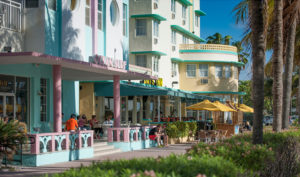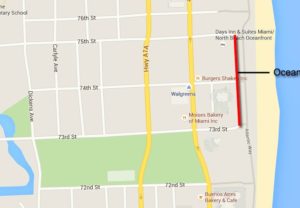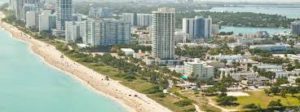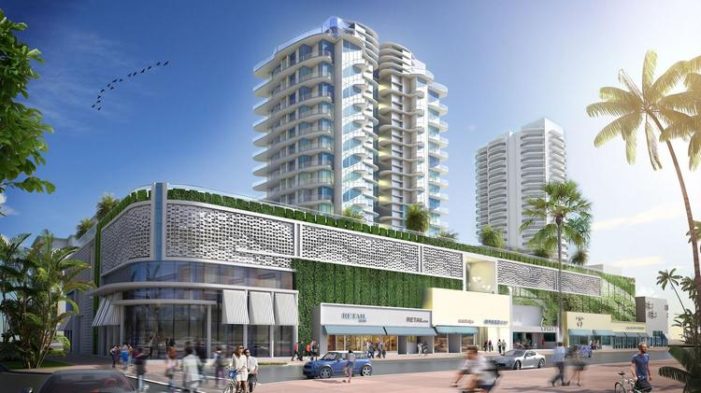The very same developers whose plans for an oceanfront highrise on North Beach were quashed by voters in 2015 have gone another route: They got the city to vacate public streets and sidewalks so they can unify a development site and use the FAR to build the condo tower anyway — and a hotel, street-level shops, restaurants and a parking garage in a $220 million project.
They’ve offered, in exchange, to build a $15 million designer park that would require closing Ocean Terrace — that last sliver of old Florida in Miami Beach — to traffic and turning it into a pedestrian promenade ala Lincoln Road. Only waterfront.
Sandor Scher and his partner Alex Blavatnik own or have interest in the property east  of Collins Avenue between 74th and 75th streets, which they intend to redevelop with a mixed use residential, hotel and retail complex. Their 2015 proposal for a mixed use hotel, residential and retail complex — which required the demolition of 11 of 13 historic hotels — was rejected by Miami Beach voters, 55 to 45 percent.
of Collins Avenue between 74th and 75th streets, which they intend to redevelop with a mixed use residential, hotel and retail complex. Their 2015 proposal for a mixed use hotel, residential and retail complex — which required the demolition of 11 of 13 historic hotels — was rejected by Miami Beach voters, 55 to 45 percent.
Four years later, they apparently found a loophole through the voters’ will by getting the city to vacate adjacent, publicly-owned parcels and easements — in short, turn over public right of way — so their project includes the square footage in the floor area ratio to get more density and taller heights.
It seems sneaky and wrong, against the very spirit of the zoning and land use rules. Especially since the city keeps control of the streets and sidewalks it is turning over just for FAR purposes — so the development doesn’t have to go to public referendum again.
Can’t you just picture Scher giving Miami Beach voters the bird?
Read related: Voters say No! to well-financed North Beach upzone question
What’s more is it is being fast-tracked by a complicit city. Everything is happening so quickly that it is hard for any opposition to muster strength, which is likely by design.
“We’re trying but it’s been so fast,” said Paula King, one of the original “red shirt” residents — so named because of their t-shirts — that helped get the  2015 referendum defeated. “The first indication of anything was in March.”
2015 referendum defeated. “The first indication of anything was in March.”
Well, the first indication was in January, when the historic preservation board gave the developers permission to tear down portions of 12 historic buildings on the stretch to make room for the project, keeping only the facades. But it does seem to moving in the city’s express lane since then.
The city’s vacation (read: abandonment) of the streets, alleys and sidewalks in the block has already been approved by both the city’s land use and finance committees, according to a 67-page Ocean Terrace development agreement draft written by the developers May 27 “subject to ongoing negotiations/revisions.” Their recommendation for approval is moving on to the full commission as a discussion item on June 26. This is a meeting that is usually reserved for proclamations and emergency items.
The sponsor is Ricky Arriola, who did not return calls. But it seems a done deal. Even Commissioner Michael Góngora, who is arguably the most skeptical or hesitant on the dais, says the project has merits.
“The city and developers have been trying for years to do something on Ocean Terrace,” Góngora told Political Cortadito, explaining that the “modified plan” puts the height on Collins Avenue instead, which raises less sensibilities.
He’s still concerned that it may too closely resemble what voters voted down in 2015. “It seems to be circumventing the will of the voters,” he said, adding that he insisted on having a public charette which was well attended by people on both the pro and con sides.
And Góngora has other issues.
“It’s a tough one for me because, number one, I don’t like vacating streets and  alleys and number two, I need to know what benefit there is to the people,” the commissioner said, adding that he wants to know the value of the FAR that the developers are getting. It could be much more than $15 million.
alleys and number two, I need to know what benefit there is to the people,” the commissioner said, adding that he wants to know the value of the FAR that the developers are getting. It could be much more than $15 million.
“We do have a number of parks in the area, but this would be elevated so you can see the water,” Góngora said, adding that the fact landscape architect Raymond Jungles is involved has people excited.
“They hear Raymond Jungles and everybody goes gaga,” Góngora said, adding that he believes the project has the votes to move forward.
“There’s people who think this will create a new vision for Ocean Terrace with cafes, boutiques, stores a la Lincoln Road, create a destination point in North Beach that doesn’t exist now.”
Even the blog on the Ocean Terrace Holdings site seems to indicate it is a done deal. “The City of Miami Beach and Ocean Terrace Holdings are working together to create increased pedestrian and public access, and activated public space along the 2-block stretch.”
The draft agreement explicitly states that there is no obligation to approve the project. But, while written by the developers’ people, it sure seems like the city is friendly to it, going so far as to lay out preliminary construction terms.
“The city has determined that the Project, the Park/Streetscape  Improvements, and the City Parcel Easement will benefit the city and the public. The Project and Park/Streetscape Improvements will help revitalize and improve the character and appearance of the surrounding neighborhood and will have a significant positive fiscal impact for the City. The Park/Streetscape Improvements will also provide a significant public amenity and increase recreational open space in the northern portion of the City.”
Improvements, and the City Parcel Easement will benefit the city and the public. The Project and Park/Streetscape Improvements will help revitalize and improve the character and appearance of the surrounding neighborhood and will have a significant positive fiscal impact for the City. The Park/Streetscape Improvements will also provide a significant public amenity and increase recreational open space in the northern portion of the City.”
But the city is in the midst of a major renovation of North Shore Open Space Park on 82nd Street and is also building a brand new park with an Olympic sized pool and parking garage on 72nd Street. Does it need a linear park in the middle of those two which are already just ten blocks apart?
What about the loss of parking revenue? Vacating the streets means vacating street parking. Or sidewalk cafe revenue? Has anybody looked at that?
Read related: Miami Beach commission election gets interesting already
In a memo to commissioners last month, City Manager Jimmy Morales indicated that the agreement was needed for the project to move forward.
“The proposed vacation would allow the developer to make its proposed mixed use project financially viable,” Morales said.
So it is about the project getting approval? And that’s the city’s role now? To help developers make their projects feasible?  To give away millions of dollars worth of public land to millionaires so they can expand their project and profit?
To give away millions of dollars worth of public land to millionaires so they can expand their project and profit?
Some residents — and the voters who rejected the earlier plan — say it is not. The city’s role, they feel, is to protect their quality of life and their interests, which they expressed in a the 2015 vote.
“It’s so dirty. It’s so unbelievable,” King said. “It screams of payoff to me.
“Not only are they allowing the developer to build higher against the previous vote, they are also giving away oceanfront property without a referendum.”
Yes, they are. They found a loophole.

